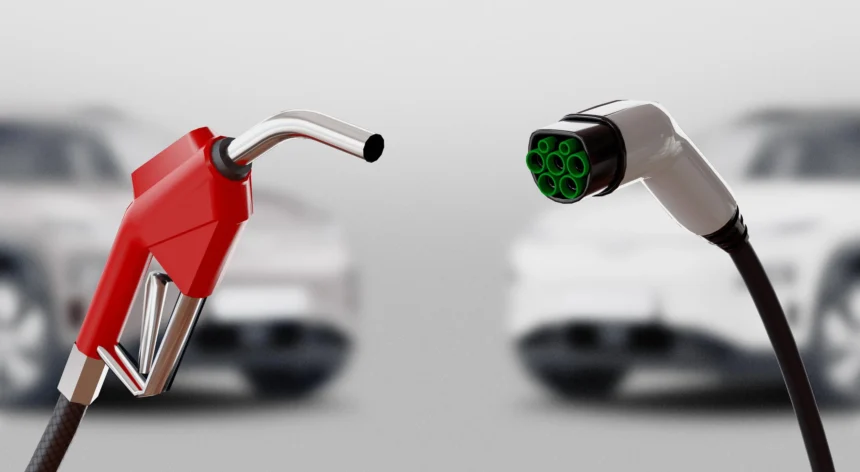Executive Summary: The Dual-Powered Investment Thesis for 2030 Are Hybrid Cars or Electric Cars the Future of Driving? Experts Weigh In
The Core Mandate: The automotive industry’s future is 100% electrified, but the journey is splitting into a necessary duopoly. Successful executives and high-value investors must adopt a dual-pathway strategy that leverages the stability of the Hybrid Electric Vehicle (HEV) to fund the disruptive growth of the Battery Electric Vehicle (BEV).
Key Findings (November 2025):
- BEV Momentum is Unstoppable: Global BEV sales surged by over 42% in Q1 2025, driven heavily by China’s dominant market share and growing affordability in key segments. BEVs are the long-term winner for their zero-emission and Software-Defined Vehicle (SDV) capabilities.
- The Hybrid Hedge: In markets like the US and Japan, hybrid vehicle sales are surging (Japan’s market share at 62% in Q1 2025), absorbing demand that has stalled for BEVs due to consumer concerns over charging infrastructure and affordability. Hybrids act as a crucial, low-risk bridge to meet intermediate emissions targets.
- High-Value Technology Focus: The highest-impact investment opportunities are concentrated in the BEV ecosystem: Solid-State Batteries (targeting 600+ Wh/kg energy density by 2030), AI-driven charging networks, and raw material supply chain security (lithium, cobalt). China is leading the charge in battery capacity and technology deployment.
- Executive Action Required: Leaders must prioritize manufacturing flexibility (platforms supporting both BEV and Hybrid), accelerate investment in battery Gigafactories, and aggressively secure critical mineral supply agreements to withstand geopolitical and supply chain volatility.
The Great Transition: Shifting from Fossil Fuels to Electrified Power
The automotive industry is in the midst of a once-in-a-century transformation. The long-term vision of a cleaner, more sustainable transportation sector is universally electric, but the path to achieving this goal is proving to be a two-pronged journey—one defined by the disruptive acceleration of the Battery Electric Vehicle (BEV) and the crucial, pragmatic bridge of the Hybrid Electric Vehicle (HEV). This duality is not a sign of stagnation but rather a reflection of the market’s maturity, driven by complex factors like infrastructure readiness, consumer affordability, and geopolitical supply chain stability.
As of late 2025, the global sales trajectory confirms that electrified vehicles—encompassing BEVs, Plug-in Hybrid Electric Vehicles (PHEVs), and traditional hybrids—are no longer a niche market. They command a significant and rapidly growing portion of new vehicle sales worldwide. However, recent data highlights a significant market nuance: while BEVs continue their aggressive growth, especially in China and Europe, the demand for hybrids is surging in key markets, acting as a vital safety net for consumers and manufacturers alike. The future is not a single technology winner; it is a powerful electrified duopoly.
The Dominance of the Electric Drive: BEVs Set the Long-Term Standard
The Battery Electric Vehicle (BEV) remains the apex predator of the automotive future. These vehicles, powered solely by an electric battery and motor, represent the cleanest, most technologically advanced form of private transportation. The high-value, high-growth investment is firmly rooted here, particularly in the supporting ecosystem of charging infrastructure and battery technology.
Surging Global Market Share
The numbers speak to an unstoppable momentum. Global sales of plug-in electric vehicles (EVs), which include BEVs and PHEVs, are on track to exceed 22 million units in 2025, capturing roughly 24% of the light-vehicle market globally.
- BEV’s Leading Role: Within this electrified segment, BEVs maintain a commanding lead. In Q1 2025, global BEV sales soared by a massive 42% year-on-year, pushing their market share to a record 16% worldwide. This dominance is driven by policy mandates, falling battery costs, and a wave of new, affordable models.
- The China Factor: China, in particular, continues to drive global BEV adoption. Its BEV sales surged by 55% in Q1 2025 and accounted for over 60% of worldwide BEV sales, establishing its unparalleled dominance in the electric mobility market. This surge is fueled by competitive pricing and supportive government measures, including trade-in schemes.
Technological Innovation: The Three Pillars
The BEV revolution is constantly fueled by breakthroughs in three critical areas that are the focus of billions in R&D investment:
- Next-Generation Batteries (Solid-State): The pursuit of the solid-state battery is key, promising greater energy density and enhanced safety. Companies are racing towards small-batch mass production by 2027, targeting energy densities of 400-500 Wh/kg initially, with the long-term goal of surpassing 600 Wh/kg for ranges exceeding 600 miles. This technology promises to solve the core limitations of current lithium-ion cells.
- Ultra-Fast Charging Networks: The expansion of reliable, ubiquitous, and ultra-fast charging infrastructure is the crucial enabler for mass adoption. The integration of Vehicle-to-Grid (V2G) and Vehicle-to-Home (V2H) capabilities is also emerging as a major trend, allowing EVs to become decentralized energy storage units that stabilize the electrical grid—a critical element of energy security.
- Software-Defined Vehicle (SDV): The BEV platform allows for unprecedented integration of Artificial Intelligence (AI) and advanced software. Over-the-Air (OTA) updates are transforming the car from a static product into a continually improving digital device, offering new services and features for long-term, high-margin revenue streams—the future of automotive commerce.
The Pragmatic Powerhouse: Why Hybrids Are Essential to the Transition
While BEVs represent the destination, the Hybrid Electric Vehicle (HEV)—including traditional hybrids and Plug-in Hybrid Electric Vehicles (PHEVs)—represents the most effective bridge to mass electrification. The surge in hybrid demand is not a rejection of electric technology but a pragmatic response to real-world consumer concerns.
The Hybrid Resurgence: Market Reality in 2025
In late 2025, consumer sentiment, particularly in North America and parts of Asia, is showing a clear preference for the flexibility and familiarity offered by hybrids:
- Addressing Range and Charging Anxiety: Hybrids eliminate the core issue of “range anxiety” by having a gasoline engine to back up the electric drive. This convenience, especially in regions with sparse or slow charging infrastructure, is a major selling point. The US market remains an outlier among advanced economies, with BEVs making up only about 7.5% of new sales, while hybrids are absorbing most of the incremental electrification demand.
- Affordability and Total Cost of Ownership (TCO): Hybrids often have a lower purchase price than comparable BEVs, making them more accessible to the mass market. Their proven reliability and lower battery degradation risk also contribute to a favorable Total Cost of Ownership (TCO), making them a rational choice for budget-conscious buyers and fleet operators.
- Regional Dominance: The Japanese market, known for its preference for reliability and compact urban transport, remains heavily dominated by hybrids, with a staggering 62% market share in Q1 2025. This shows that in highly developed markets, the perceived inconvenience of charging can still favor the HEV model.
Advanced Hybrid Architecture
Automakers, particularly those focused on cost-effective compliance, are investing heavily in sophisticated new hybrid architectures.
- Refined Power Trains: Modern hybrid systems feature highly efficient, next-generation engines paired with advanced electric motor systems and sophisticated energy management control that optimizes drive modes to maximize fuel efficiency and performance.
- PHEV’s Dual Role: PHEVs are proving increasingly popular, particularly in China and emerging markets like Brazil and Mexico, where they are gaining strong traction. They offer a significant all-electric range for daily commutes while mitigating the long-haul dependency on charging infrastructure, serving as an effective dual solution for diverse driving conditions.
Long-Term Forecast: The Duopoly’s Enduring Reign to 2030
The trajectory for the next decade confirms that both BEVs and hybrids will continue to dominate the market, gradually pushing the pure ICE vehicle toward obsolescence. Global plug-in vehicle sales (BEV + PHEV) are projected to nearly double to 40.7 million units by 2030, representing a market share of over 40%.
| Vehicle Type | 2025 Global Sales Share (Estimate) | 2030 Global Sales Share (Forecast) | Primary Growth Drivers |
| Battery Electric (BEV) | ~16% | ~40-50% | Falling battery costs, policy mandates, technology leaps |
| Plug-in Hybrid (PHEV) | ~8% | ~10-15% | Consumer range anxiety, commercial fleet flexibility, affordability |
| Traditional Hybrid (HEV) | ~10% | ~5-10% | Developed markets bridge, strong demand in emerging economies |
| Total Electrified | ~34% | ~55-75% | Regulatory pressure and consumer TCO focus |
Note: Estimates based on aggregated IEA and BNEF forecasts for 2025 and 2030. The range reflects policy uncertainty.
Investment Opportunities and Strategic Shifts
- Critical Mineral Security: The lithium market, which saw volatility in 2024, is now showing signals of a new bull cycle driven by accelerating BEV adoption and expansion of energy storage systems (grid stabilization). Securing long-term lithium supply agreements remains a top-tier financial imperative.
- Manufacturing Flexibility: The slowdown in BEV adoption rates in some markets is prompting Original Equipment Manufacturers (OEMs) to shift production capacity. OEMs with highly flexible modular platforms capable of quickly scaling hybrid and PHEV production are best positioned to navigate consumer sentiment shifts and avoid inventory build-up.
- Technology Deployment: The race in Solid-State Batteries is concentrated in China, with companies planning significant production capacity. The successful commercialization of this technology—which promises greater safety and energy density—will fundamentally reshape the competitive landscape after 2027.
Conclusion: A Phased, Intelligent Electrification
The future of the car is electric, but the journey is not a straight line. The data for late 2025 clearly shows that both the Battery Electric Vehicle and the Hybrid Electric Vehicle are essential components of the transition.
The BEV represents the necessary technological leap, offering the ultimate in zero-emission transport and digital connectivity. It is the long-term goal. The Hybrid—in both its traditional and plug-in formats—is the vital, highly pragmatic solution that meets current consumer needs for affordability, convenience, and peace of mind while infrastructure catches up. This dual-pathway approach ensures both immediate compliance with emissions regulations and a sustainable funding model for the revolutionary BEV technology.
Source Reference and Further Reading:
- IEA: Global EV Outlook 2025 (Accessed November 19, 2025).
- BloombergNEF: Electric Vehicle Outlook 2025 (Accessed November 19, 2025).
- PwC Strategy&: Electric Vehicle Sales Review Q1-2025 (Accessed November 19, 2025).
- S&P Global: EV adoption rates: How the US and other markets compare in 2025 (Accessed November 19, 2025).
- EVreporter: China’s Solid-State Battery Shipments (Accessed November 19, 2025).











